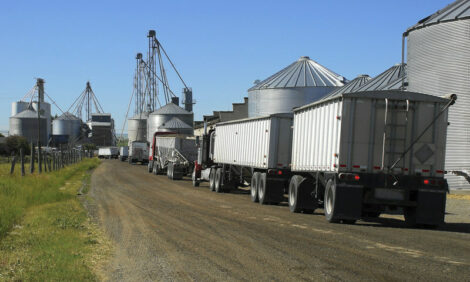



"Have the guts to invest in a new era at full throttle" says report
UK - A draft report calls for the pig industry's spend on research to be stepped up to around 33m a year. It says at least six technical reps should be appointed immediately to pass on research to producers. And it calls for a new 32m development centre, housing a 500-sow pig unit.|
NPA is active on members' behalf in Brussels & Whitehall, and with processors, supermarkets & caterers – fighting for the growth and pros-perity of the UK pig industry. |
The report - "Long-term Research and Development Priorities for the British Pig Industry" - has received an initial nod of approval from the National Pig Association and now will be considered in detail by BPEX.
The report says a new, bigger and more focussed research and development programme will create considerable gains for producers. It claims, for example, that 355m invested over ten years in enteric disease research could produce a net return for the industry of as much as 334.6m. And the total gain from a new ten-year research programme could be 3750m after costs deduction of costs of 350m.
BPEX will have to decide whether the industry can afford such a profound hike in research and development spending, and which services will have to be cut to pay for it. "Finding the money will be a challenge," said BPEX chairman Stewart Houston, "and we will have to balance cost with return."
BPEX has an income from the producer and processor general levy of around 33.8m, with a further from the producer 65p promotion levy. Currently from its 33.8m general levy income it devotes nearly half ( 31.8m) to technical matters, including research projects and the running of Stotfold Pig Development Centre.
It is argued that levy money spent on research is good value because, as a rule, for every 40p invested by producers and processors, Defra adds a further 60p.
Stewart Houston has stressed that it is a draft report. "BPEX have produced what I consider to be a really good piece of work but nobody should see it as all done and dusted. It is a draft review, which we hope will help take the industry forward over the next five to 15 years," he said.
Written by an independent consultant, "Long-term Research and Development Priorities for the British Pig Industry" is the work of a working group of MLC and BPEX staff and members, an independent scientist, a representative of Defra and representatives from genetics companies.
It is based on a hit list of research priorities identified by a pan-industry workshop at which all sectors were represented, including processors, retailers, government, supply companies and scientists.
They said the most glaring problem with current industry research is that it is not effectively explained to producers and as a result there is a poor uptake of new ideas.
The report acknowledges that without a government advisory service and with fewer technical specialists employed by supply companies the process of communication is more difficult these days.
It says research funders BPEX and Defra should make it their responsibility to ensure the benefits of research are taken up by producers, though this will require "substantial resources".
It proposes the immediate formation of what effectively would be a pig advisory service, staffed by six or more technical representatives at a cost of 360,000 a year each. The service would be paid for from the producer/processor levy with some funding from the Red Meat Industry Forum and the Agricultural Development Scheme.
Stressing the need for such action, it claims many producers are unaware of the details of the existing BPEX research programme. The research and development workshop threw up many suggestions as to how research information could be communicated - technical magazines, wallcharts, the internet etc.
But key to all the report's proposals is the bringing together all sectors of the industry at a new Pig Development Centre which would replace Stotfold which "clearly does not play this role at present" and which in any case has property development value.
It says a new centre - which should include a 500-sow pig unit - would be a place where…
Research is translated into practical guidance for producers.
Scientists can work part-time on their particular projects.
Farm trials will take place.
Industry-funded advisers will be based.
Producers and processors will visit to keep up to date with new ideas and best practice.
Overseas visitors will be welcome, enabling Britain to trade new ideas with other countries.
The report says a new pig development centre is pivotal to revitalising the technical skills of the industry. Without it, the pay-off from research work will be halved… "It really is that crucial and its marginal costs is very low."
The cost of a new 500 farrow-to-finish development centre would be 32m, excluding the land but not including income from the possible sale of the Stotfold site.
The report has been presented to BPEX itself, the NPA's Technical and Scientific Committee and NPA's Producer Group. "At each of these meetings it was subjected to strong scrutiny and several suggestions have been made which will be adapted into the report," said Stewart Houston.
On Tuesday this week (July 20) the participants who took part in the original research and development workshop last year will meet to discuss the report. "I have no doubt they will find ways of improving it and will agree or otherwise that it is a faithful reflection of the ideas they put forward for the next five to 15 years."
The industry could not afford to ignore research and development, he said. "It's not a case of if we do it, but how we do it."
He said that like a lot of the work done by BPEX and NPA it would never be a finished product but would continue to evolve to react to change and to meet the industry's needs.
He said "Long-term Research and Development Priorities for the British Pig Industry" embraced the need for cooperation and collaboration, as seen in the industry's finisher pig and weaner research. It called for a mindset change among both producers and academics so that in the future people in the industry worked together rather than in competition.
"In the 70s and 80s Britain was at the forefront of research but our lead has been eroded albeit by the obvious circumstances of the past five or six years and our research base has been depleted. The aim now is to provide ideas from the bottom up for a research programme covering exactly what producers needed, and to enthuse academics to deliver it."
The costs to the industry of a new research and development strategy based on a new pig development centre have been outlined by the report working party.

The report says BPEX could select various cut-off points for strategic research costs - 31m, 31.5m, 32.2m - but benefits and value for money are greatest at the highest given figure of 32.2m. The industry, it says, should "have the guts to invest in a new era at full throttle."
New research programmes that could be deployed to meet the industry's need are identified as follows:
Disease
Production systems: enteric
Explore the impact of production systems on gut health in order to minimise enteric disease pathogenicity, incidence and severity.
Production systems: respiratory
Explore the impact of production systems in order to minimise respiratory disease pathogenicity, incidence and severity.
PMWS
Roll out current knowledge and best practice
Feed X disease interaction
How dietary components affect gut function and enteric disease.
Nutrient Management
Protein requirements of genotypes
Optimise the protein specification and feed regime for each main genotype to reduce lean growth cost and minimise waste.
Precision feeding
Feed composition and regime to be optimised precisely along the whole growth continuum from birth to slaughter and to optimise the performance of breeding sows.
Raw material optimisation
Explore new varieties, GM crops, protein and nutrient balance, fermentation, co-products, nutrient release, gut health to reduce costs.
Genetic Improvement
Disease resistance
Identify genes and/or genotypes that confer disease resistance.
Genotype testing
Continuous testing of various commercial genotypes.
Biological performance
Lean tissue growth rate, reproduction, nutrient retention eg N, meat quality.
Consumer
The balanced plate
Promote the health benefits of pork consumption within the context of a healthy balanced diet.
Meat quality
Production and processing regimes to enhance eating quality
Manufacturing
Processing best practice
Apply lean manufacturing and similar principles to maximise manufacturing efficiency, quality and service levels.
The report argues that all research should comply with a ten key points.
It must be hypothesis driven, which means there must be a valid hypothesis to support the expected outcome of the proposed technical or other intervention or change to a business process. This does not require certainty.
BPEX shall require that any pig research is subject to a flow of strategic research, development, demonstration and extension (putting into practice). Depending on the start point, each project shall have both a budget and delivery milestones in respect of each phase. Where possible, this will be conducted in parallel in order to minimise the time to uptake.
As pig research is aimed at changing processes and practices to enhance long-term competitiveness, BPEX research must include demonstration, extension and communication activities to maximise uptake of new processes and practices.
BPEX will only fund pig research that would not be undertaken by the industry, individual business or supply chain groups without BPEX funding. Normally, this means the research will be for the common benefit of the whole sector (or pre-competitive). But this definition means that individual and group schemes to accelerate process or practice improvement, can be initiated by BPEX.
Since pig research is aimed at providing the evidence and catalytic activity for change, BPEX will, at least every two years, conduct a practice audit across the whole pig sector in order to measure the relative change being achieved by the research.
At least every three years, BPEX will set out its pig research priorities together with the technical programmes it considers most likely to deliver.
As and when new projects are initiated by BPEX, they will, where appropriate, be subject to procurement best practice based on published research briefs and open tendering. However, BPEX may use its discretion in such matters as long as it is open about it.
Any internal resources (such as technical staff and the development unit) will be allowed to undertake competitive work funded by others provided this does not compromise the BPEX pig research programme and the work is charged at full economic cost and any surplus is returned to the BPEX research budget.
Pig research will be conducted with maximum transparency consistent with protecting the competitiveness of the UK pig sector for BPEX-funded research and specific clients in respect of competitive work.
BPEX shall set up such research management structures that will enable it to fulfill the implications of all the above points. This will involve inclusion of both knowledge chain and supply chain expertise.
-
Stewart Houston, chairman, MLC, NPA, BPEX.
Derek Armstrong, MLC.
Mike Attenborough, MLC.
Zoe Davies, Defra.
Ian Brisby, JSR.
Sue Corning, PIC.
Jon Easey, BPEX.
Pinder Gill, MLC.
John Godfrey, producer.
Fred Gordon, independent scientist.
Janice Harland, PMS.
Paul Kirk, MLC.
Gordon McKen, QMS representative.
Philip Richardson, NPA.
Mick Sloyan, BPEX.
Lisa Taylor, MLC.
David Thelwall, PMS consultant (report author).








